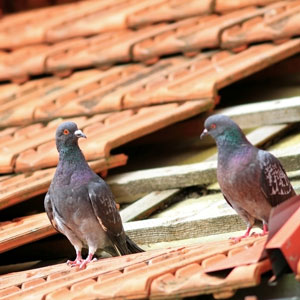Bird Droppings Can Be Hazardous to Your Health
By Chris Williams on November 8, 2013.
 Question
Question
I want to clean out an old shed on the roof of our apartment building. Nobody’s been using it except the pigeons. My friend said that it’s dangerous to mess with pigeon droppings. Is that true?
Answer
Your friend did you a favor. It’s true that bird droppings can be hazardous to your health, especially if they have been accumulating for awhile. The main concern are fungal diseases, histoplasmosis and cryptococcosis, that grow on the droppings. When the droppings are disturbed, the fungal spores can become airborne, can be inhaled, and can cause respiratory symptoms and other problems.
Both histoplasmosis and cryptococcosis are respiratory diseases. Most infected people have no symptoms; others have mild, flu-like symptoms. Occasionally, victims suffer serious, even fatal, symptoms. About 800 people die in the U.S. each year from complications of histoplasmosis.
Cryptococcus is mostly found in pigeon droppings and the age of the droppings doesn’t appear to be a factor. Histoplasmosis is less common in pigeon roosts (but see Case Study below) and usually develops only in bird roosts where droppings have accumulated for at least 3 years. Accumulations of bat droppings can also be a problem. Risk increases with the amount of disturbance of the droppings and length of exposure. Droppings that are dry and can easily become airborne are most hazardous.
The people that need to be aware of this potential hazard are those that might be shoveling or moving droppings, either just to clean an area or when renovating a building or excavating a roosting site. Anyone working with accumulated bird droppings needs to be aware of the hazards and take the proper precautions which include wetting the droppings and use of a special respirator.
Case Study
Pigeon droppings had accumulated to a depth of one foot on the catwalk around an Arkansas courthouse tower. Cleanup workers shoveled the dry droppings off the catwalk, allowing them to fall four stories to the ground. Air conditioners picked up the falling spore-laden dust and distributed it within the building. Of the 84 employees inside, 52% developed fever, cough, chest pain, myalgia, and/or evidence of histoplasmosis. An additional 24 cases of histoplasmosis occurred among construction workers and people who visited the courthouse during the cleanup.
The hazards associated with bird droppings are just one of the risks when pigeons, starlings, or house sparrows are allowed to roost in and on inhabited buildings. Pest bird management is one of our specialties at Colonial Pest Control. If you’re living with pest birds, give us a call.